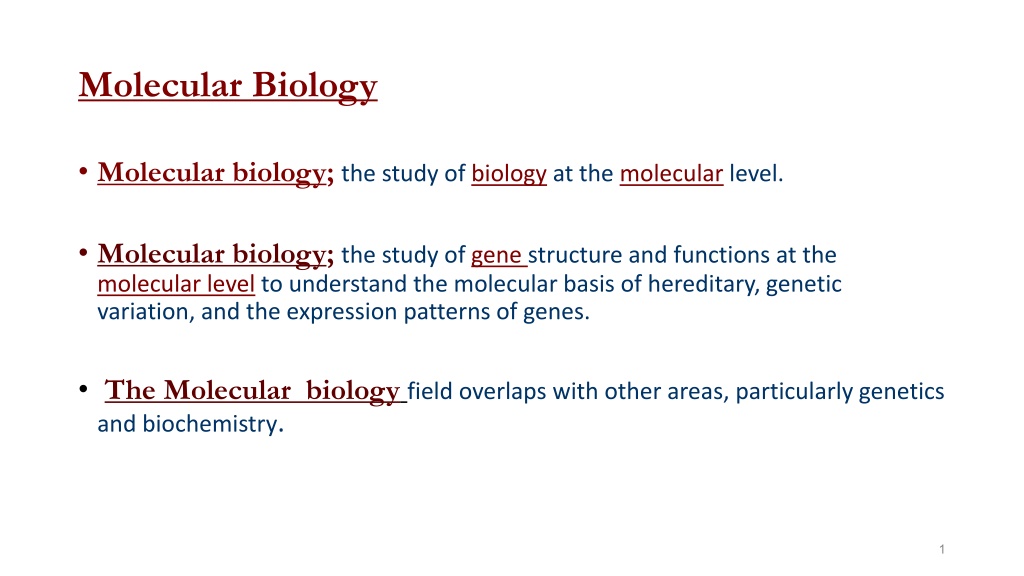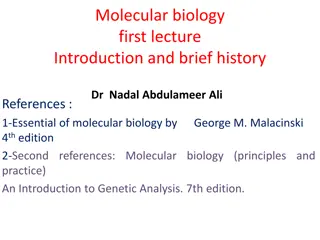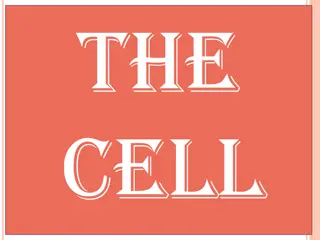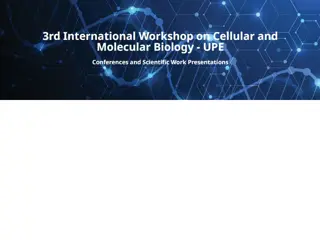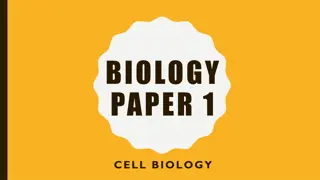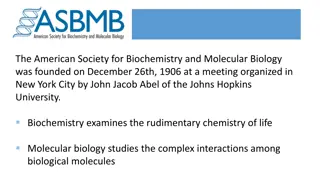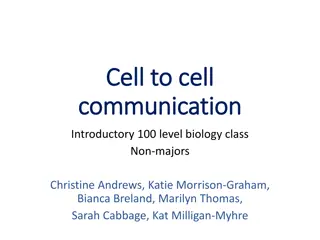Exploring Molecular Biology and Cell Science
Molecular biology delves into the study of biology at the molecular level, focusing on gene structure and functions to comprehend hereditary traits, genetic variation, and gene expression patterns. Cells, the fundamental units of life, vary in shape and function but share basic structures. The Three Domains of Life categorize living organisms under Eukaryotes, Prokaryotes, and Archaea. Eukaryotic cells possess a true nucleus, while Prokaryotic cells lack a defined nucleus. Deoxyribonucleic Acid (DNA) serves as the genetic blueprint for cellular organisms and viruses, encoding vital information for life. Dive into the intricate world of molecular biology and cellular processes to unravel the essence of life itself.
Download Presentation

Please find below an Image/Link to download the presentation.
The content on the website is provided AS IS for your information and personal use only. It may not be sold, licensed, or shared on other websites without obtaining consent from the author. Download presentation by click this link. If you encounter any issues during the download, it is possible that the publisher has removed the file from their server.
E N D
Presentation Transcript
Molecular Biology Molecular biology;the study of biology at the molecular level. Molecular biology;the study of gene structure and functions at the molecular level to understand the molecular basis of hereditary, genetic variation, and the expression patterns of genes. The Molecular biology field overlaps with other areas, particularly genetics and biochemistry. 1
The Cell Cellsare stacked together to make up structures, tissues and organs. Most cells have got the same information and resources and the same basic material. Cells can take many shapes depending on their function. Function of cells Secretion (Produce enzymes). Store sugars or fat. Brain cells for memory and intelligence. Muscle cells to contract. Skin cell to perform a protective coating. Defense, such as white blood cells. 2
Three Domain of Life All living things are grouped into three domain: Eukaryotes; Prokaryotes and Archaea. 3
The Cell The cellis the smallest living unit, the basic structural and functional unit of all living things. Some organisms, such as most bacteria, are unicellular (consist of a single cell). Other organisms, such as humans, are multicellular. 4
Eukaryotic Cell Cell with a true nucleus, where the genetic material is surrounded by a membrane; Eukaryotic genome is more complex than that of prokaryotes and distributed among multiple chromosomes; Eukaryotic DNA is linear; Eukaryotic DNA is complexed with proteins called "histones; Numerous membrane-bound organelles; Complex internal structure; Cell division by mitosis. 5
Prokaryotic Cell Unicellular organisms, found in all environments. These include bacteria and archaea. Without a nucleus; no nuclear membrane (genetic material dispersed throughout cytoplasm ; No membrane-bound organelles; Cell contains only one circular DNA molecule contained in the cytoplasm; DNA is naked (no histone); Simple internal structure; and Cell division by simple binary fission. 6
Deoxyribonucleic Acid (DNA) Deoxyribonucleic Acid (DNA), the genetic material of all cellular organisms and most viruses, the gigantic molecule which is used to encode genetic information for all life on Earth. 7
http://genome.gsc.riken.go.jp/hgmis/graphics/slides/01-0085jpg.htmlhttp://genome.gsc.riken.go.jp/hgmis/graphics/slides/01-0085jpg.html U.S. Department of Energy Human Genome Program, http://www.ornl.gov/hgmis. 8
The Chromosome Thread like structure. Located in the cell nucleus. The storage place for all genetic information. The number of chromosomes varies from one species to another. 9
The Chromosome In normal human cell DNA contained in the nucleus, arranged in 23 pairs of chromosomes ; 22 pairs of chromosomes (autosomes) ; the 23 chromosome pair determines the sex of individual and is composed of either two (x) chromosomes (female) or an (x) and (y) chromosome (male). 10
The Gene The basic units of inheritance; it is a segment within a very long strand of DNA with specific instruction for the production of one specific protein. Genes located on chromosome on it's place or locus. 11
General Structure of Nucleic Acid DNA and RNA are long chain polymers of small compound called nucleotides. Each nucleotide is composed of a base; sugar (ribose in RNA or deoxyribose in DNA) and a phosphate group. The phosphate joins the sugars in a DNA or RNA chain through their 5` and 3` hydroxyl group by phosphodiester bonds. 12
General Structure of Nucleic Acid DNA and RNA are long chain polymers of small compound called nucleotides. Each nucleotide is composed of a base; sugar (ribose in RNA or deoxyribose in DNA) and a phosphate group. The phosphate joins the sugars in a DNA or RNA chain through their 5` and 3` hydroxyl group by phosphodiester bonds. 13
The structure of DNA was described by British Scientists Watson and Crick as long double helix shaped with its sugar phosphate backbone on the outside and its bases on inside; the two strand of helix run in opposite direction and are anti-parallel to each other. The DNA double helix is stabilized by hydrogen bonds between the bases. This structure explains how genes engage in replication, carrying information and acquiring mutation. The G+C content of a natural DNA can vary from 22-73% and this can have a strong effect on the physical properties of DNA, particularly its melting temperature. 14
There are four different types of nucleotides found in DNA, differing only in the nitrogenous base: A is for adenine; G is for guanine; C is for cytosine and T is for thymine. These bases are classified based on their chemical structures into two groups: adenine and guanine are double ringed structure termed purine , thymine and cytosine are single ring structures termed pyrimidine. The bases pair in a specific way: Adenine A with thymine T (two hydrogen bonds) and guanine G with cytosine C (three hydrogen bonds). Within the structure of DNA, the number of thymine is always equal to the number of adenine and the number of cytosine is always equal to guanine. In contrast to DNA; RNA is a single stranded, the pyrimidine base uracil (U) replaces thymine and ribose sugar replaces deoxyribose. 15
Genomic DNA organization Eukaryotic genes:DNA molecules complexed with other proteins especially basic proteins called histones, to form a substance known as chromatin. A human cell contains about 2 meters of DNA. DNA in body could stretch to the sun and back almost 100 times. So it is tightly packed. 17
Eukaryotic Chromatin Eukaryotic chromatinis folded in several ways. The first order of folding involves structures called nucleosomes, which have a core of histones, around which the DNA winds ( four pairs of histones H2A, H2B,H3 and H4 in a wedge shaped disc, around it wrapped a stretch of 147 bp of DNA). 18
DNA Forms 19
How Molecular Biology came about? Microscopic biology began in 1665 Robert Hooke Robert Hooke (1635-1703) discovered organisms are made up of cells Matthias Schleiden (1804-1881) and Theodor Schwann (1810- 1882) further expanded the study of cells in 1830s Theodor Schwann Matthias Schleiden
history of Molecular Biology history of Molecular Biology 1800 1800 - - 1870 1870 1865Gregor Mendel discover the basic rules of heredity of garden pea. An individual organism has two alternative heredity units for a given trait (dominant trait v.s. recessive trait) 1869 Johann Friedrich Miescher discovered DNA and named it nuclein. Gregor Mendel Johann Miescher
history of Molecular Biology history of Molecular Biology 1880 1880 - - 1900 1900 1881Edward Zacharias showed chromosomes are composed of nuclein. 1899 Richard Altmann renamed nuclein to nucleic acid. By 1900, chemical structures of all 20 amino acids had been identified
history of Molecular Biology history of Molecular Biology 1900 1900- -1911 1911 1902 - Emil Hermann Fischer wins Nobel prize: showed amino acids are linked and form proteins Postulated: protein properties are defined by amino acid composition and arrangement, which we nowadays know as fact Emil Fischer 1911 Thomas Hunt Morgan discovers genes on chromosomes are the discrete units of heredity Thomas Morgan 1911 Pheobus Aaron Theodore Lerene discovers RNA
history of Molecular Biology history of Molecular Biology 1940 1940 - - 1950 1950 1941 George Beadle and Edward Tatum identify that genes make proteins 1950 Edwin Chargaff find Cytosine complements Guanine and Adenine complements Thymine George Beadle Edward Tatum Edwin Chargaff
history of Molecular Biology 1986 - 1995 1986 Leroy Hood: Developed automated sequencing mechanism 1986 Human Genome Initiative announced 1990 The 15 year Human Genome project is launched by congress 1995 Moderate-resolution maps of chromosomes 3, 11, 12, and 22 maps published (These maps provide the locations of markers on each chromosome to make locating genes easier)
history of Molecular Biology 1995-1996 1995 John Craig Venter: First bactierial genomes sequenced 1995 Automated fluorescent sequencing instruments and robotic operations 1996 First eukaryotic genome-yeast-sequenced
history of Molecular Biology 1997 - 1999 1997 E. coli sequenced 1997: dolly sheep cloned 1998 PerkinsElmer, Inc.. Developed 96- capillary sequencer 1998 Complete sequence of the Caenorhabditis elegans genome 1999 First human chromosome (number 22) sequenced
history of Molecular Biology 2000-2001 2000 Complete sequence of the euchromatic portion of the Drosophila melanogaster genome 2001 International Human Genome Sequencing:first draft of the sequence of the human genome published
history of Molecular Biology 2003- Present April 2003 Human Genome Project Completed. Mouse genome is sequenced. April 2004 Rat genome sequenced.
Old biotechnology Arose from Zymotechnology-brewing yeast beer, lactic acid, acetone Karl Ereky coined the term Biotechnology -1917 Penicillin-1940s Steroids-cortisone-1950s Single cell proteins-1960s
Beginning of new biotechnology Reverse transciptase-Temin Baltimore-1970 Restriction endonuclease-Arber, Nathans, Smith-1971 Stanley Cohn and Herbert Boyer constructed first recombinant DNA molecule and cloned in bacteria-E.coli
